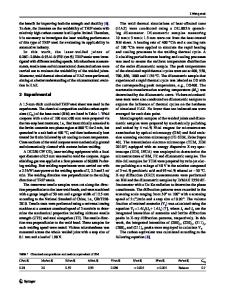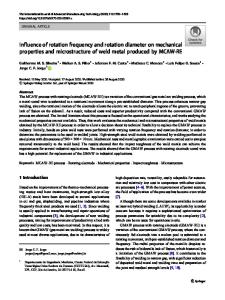Influence of Tool Dimension and Welding Parameters on Microstructure and Mechanical Properties of Friction-Stir-Welded 6
- PDF / 779,486 Bytes
- 11 Pages / 593.972 x 792 pts Page_size
- 58 Downloads / 382 Views
INTRODUCTION
FRICTION stir welding (FSW) is considered to be the most significant development in metal joining in recent years and is a ‘‘green’’ technology due to its energy efficiency, environment friendliness, and versatility.[1] This technique is being applied to the aerospace, automotive, and shipbuilding industries, and is attracting an increasing amount of research interests. For the precipitation-hardened aluminum alloys, FSW creates a softened region in the heat-affected zone (HAZ) that has the lowest hardness within the entire weld, due to significant dissolution/coarsening of the precipitates during the FSW thermal cycle.[2–6] Therefore, the hardness profile of the FSW aluminum alloy joint is a direct indicator of microstructural evolution during FSW. In the previous studies, the hardness profiles were measured either along the midthickness of the FSW plate or along the top, center, and bottom of the plate thickness to determine the lowest hardness points.[1] However, it should pointed out that such hardness profiles could not predict the fracture behavior of FSW aluminum alloy joints because of the limited lowest hardness points.[1] In a recent study, Ren et al.[7] constructed a hardness distribution map around the HAZ throughout the entire thickness of 6-mm-thick FSW 6061Al-T651 plates. It was indicated that the fracture path of the welds was consistent with the lowest hardness distribution. F.C. LIU, Postgraduate, and Z.Y. MA, Professor, are with the Shenyang National Laboratory for Materials Science, Institute of Metal Research, Chinese Academy of Sciences, Shenyang 110016, P.R. China. Contact e-mail: [email protected] Manuscript submitted December 24, 2007. Article published online July 15, 2008 2378—VOLUME 39A, OCTOBER 2008
It is well documented that both welding parameters and tool geometry exert significant effects on the mechanical properties of the FSW aluminum alloy joints.[7–15] For example, Scialpi et al.[11] reported that the best FSW 6082Al joint was produced by a shoulder with fillet and cavity. However, the investigation by Fujii et al.[10] indicated that the tool shape did not affect the mechanical properties of FSW 6061Al-T651 joints significantly. However, they did not give a detailed explanation. On the other hand, the effect of the tool rotation rate or the welding speed on the mechanical properties of the FSW joints was examined by several investigators. Lee et al.[14] reported that both strength and elongation of FSW 6061Al-T651 joints decreased with decreasing the welding speed and increasing the rotation rate.[15] More recently, Ren et al.[7] reported that while the rotation rate did not influence the tensile properties of FSW 6061Al-T651 joints, increasing the welding speed increased the strength of the joints remarkably. It was widely reported that the fracture of the FSW joints of the precipitation-strengthened aluminum alloys usually occurred in the HAZ. In this case, the mechanical properties of the welds are governed by the microstructure of the HAZ that is dominated by the thermal exposur
Data Loading...











